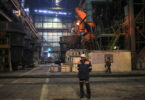LITOVKIN Dmitry
For the first time in history, the Project 885 multipurpose nuclear submarine of the Severodvinsk type used the Zircon hypersonic cruise missiles. The vehicles were launched both from the surface of the ship and from underwater from a depth of 40 meters. The military department recognized the tests as successful, and Defense Minister Sergei Shoigu said bluntly that the missile would be put into service in the near future.
However, even before that moment, at the Army-2021 exhibition-forum, the Ministry of Defense signed a contract with the MIC NPO Mashinostroyenia JSC (part of the Tactical Missile Armament Corporation) from Reutov near Moscow for the supply of a batch of these unique products. The nuance is that such decisions are made in exceptional cases – only when the customer is absolutely sure of the result and because of the importance of the case is ready to turn a blind eye to legal formalities.
“Stone” heritage
JSC “MIC NPO Mashinostroyenia” is a unique company. Its founder, Vladimir Nikolaevich Chelomey, is a man of a difficult character and remarkable courage and will. In the last century, it provided our fleet with a strategic advantage in the use of cruise missiles. Machines with “stone” names: “Amethyst”, “Malachite”, “Basalt”, “Granite”, “Onyx” and, finally, “Zircon” – provided, ensure, and now determine the dominance of our fleet at sea. NPOmash’s developments are today on nuclear submarines of project 949 of the “Orel” type, cruisers of project 1144 of the “Peter the Great” type, the only aircraft-carrying cruiser of project 1143.5 “Admiral of the Fleet of the Soviet Union Kuznetsov”, as well as on the most promising nuclear-powered ships of the project 885 type “

Looking into the past, you understand the gigantic legacy left by the designer of the first cruise missiles. A dreamer and, perhaps, in a good sense of the word, an adventurer Vladimir Chelomey. People who knew him personally say that he did not take on small projects. Cruise missiles were a priority, but Vladimir Nikolaevich was building a scientific and technological empire. There was sea and space in it. It was NPOmash who built the first Soviet combat orbital station “Almaz”, created a satellite on a nuclear power plant and many, many things, which, apparently, have not yet been declassified due to their prospects.
This passage is not accidental. In his message to the Federal Assembly in 2018, President Vladimir Putin announced the appearance of two hypersonic products at once: the Avangard maneuvering nuclear unit and the Zircon cruise missile. He also revealed some of the characteristics of these products. The first one flies at a speed of 30, the second rocket accelerates to Mach 9. For understanding, in the first case we are talking about a speed of 36 thousand, in the second about 11 thousand km per hour. Fantastic! NPOmash does not think so. The foundation built by Chelomey was built on by his successor, Herbert Alexandrovich Efremov. It is his merit in the fact that the Avangard nuclear unit, which was apparently developed back in the 70s, reached its goal.
Deputy Defense Minister Alexei Krivoruchko said that the deployment of a full-fledged Avangard complex regiment will be completed in the Strategic Missile Forces by the end of this year. A regiment is, if you follow the open documents of the Strategic Missile Forces, ten vehicles.
Mind games
I met the current head of the MIC NPO Mashinostroyenia JSC, Alexander Georgievich Leonov, in the mid-90s. Then, for the first time, journalists and defense workers were allowed to communicate. Honestly, not from a good life – there is perestroika in the country, and rockets, satellites and orbital stations are no longer needed. There is only one way out – to sell all this abroad. In general, all this was the leitmotif of our meetings. Leonov created and marketed the P-800 Onyx cruise missile. The machine, like all NPOmash products of different times, turned out to be unique: compact, three times smaller than the most serious missile system of our fleet, the P-700 Granit, but at the same time just as smart and cunning. The point is that in “Granite” artificial intelligence of the human type was applied for the first time. For 1983 – and development began in 1975 – the thing is so extraordinary, needless to say. There were no microcircuits and superprocessors at that time. Nevertheless, “Granite” thought and decided for himself what to do in battle.

For this purpose, electromagnetic portraits of all modern ships of foreign fleets were incorporated into the on-board computer systems of the machines. Our submariners are daily engaged in “photographing” them during combat duty in the World Ocean. All this allows the rocket, after launch, to accurately identify the target, as they say, by name, to understand what kind of transport, frigate, destroyer, aircraft carrier, etc. in front of her. But that’s not all. “Granite” works in a flock. Nuclear cruisers like “Eagle” or “Peter the Great” can simultaneously launch up to 24 missiles. This is where the mind games begin.
The first missile, leaving the mine, will “wait” for the last partner, after which the vehicles will line up and start attacking the target. Only one target can see. She organizes the attack, passing on information where the victim is and who is guarding her. Then the machines will decide who is attacking and who is diverting air defense fire towards themselves. After destroying the main target in the order, the missiles will redistribute roles and again begin to sting the survivors. In general, a swarm of bees in action. A salvo of the P-700 will definitely lead to the sinking of an enemy aircraft carrier formation. Onyx works the same way. It is only after the modernization of the project 1144 cruiser “Admiral Nakhimov”, according to some reports, three new P-800 missiles will be delivered to each of the Granit mines. That is, there will already be 72 flying Terminators in the strike.
Apple from apple tree
About “Granite” and “Onyx” I remember not just like that. The Zircon rocket is known only from the words of President Vladimir Putin – hypersonic, with a speed of Mach 9, it flies a thousand kilometers. Also, according to him, in a conversation with Herbert Efremov during the assignment of the Order of St. Andrew the First-Called, the head of state said that he talked “face to face” with Leonov and asked him “what to do next” after a series of failures with testing a promising machine.
“He said very wonderful words with complete confidence. He said: give us a chance, we will do it. And six months later, the point was drawn,” Vladimir Putin said.
Even after these words, NPOmash does not comment on its involvement in the project. Although the head of the KTRV holding Boris Obnosov at the recent MAKS-2021 aerospace show in Zhukovsky near Moscow, during a press briefing, was still forced to give an answer about Zircon: “Of course, these terms have been agreed with the customer, everything is going in accordance with the approved test schedule I’m afraid, as they say, to jinx it, but let’s hope that we will meet these deadlines, although the system is very complex. I personally participated in a number of launches and I must say that the impression is amazing. – emphasized Boris Obnosov.
The scale of the problem is clear. Soviet missiles reached hypersonic speeds back in the 70s of the last century. But this was achieved by the fact that the car was accelerated either by a ballistic missile or by a carrier aircraft. For example, such as the MiG-31, capable of flying at a speed of 3 thousand km per hour. In contrast, “Zircon” starts and flies independently on hypersound. This is a technological breakthrough. After all, if you look closely, to create such a machine, an engine was required, most likely an air-jet, Herbert Efremov himself indirectly hinted about this in one of his conversations with me. It needs fuel. In his own words, this is bicillin obtained from vacuum gas oil using hydrogenation processes.
“This liquid fuel has a very high density, which makes it possible to make a tank with a smaller volume,” said Herbert Efremov, Honorary General Director and Honorary General Designer of JSC VPK NPO Mashinostroyenia.
Well, there are additional nuances: this is a “sacrificial layer,” as Efremov said. It is a material that can withstand the thermal load on the vehicle during ultra-high-speed flight. Here he cited as an example completely different devices and equipment. For example, the same “Buran”. The shuttle “fell” into the atmosphere at a speed of Mach 25. And today at VDNKh on his “belly” you can see the very magic armor – black tiles that did not allow him to burn in the dense layers of the atmosphere.
The “burning” rate of “Zircon” is 2.5 thousand degrees. It turned out by chance too. At the last military exhibitions KTRV actively promoted the “carbon-carbon” composite. As part of diversification, it is planned to produce joint endoprostheses from it. By its properties, as noted by rocket scientists, it is very similar to human bone tissue. This is the very ideal material that, unlike titanium, takes root in the human body and does not require repeated operations to replace it. Well, in military terms – “skin” “Zircon” and “Vanguard”.
Well, one more nuance. The appearance of “Zircon” was to some extent declassified by the Indian colleagues of NPOmash from BrahMos Aerospace Limited. They have repeatedly demonstrated their hypersonic rocket during international aerospace shows. Outwardly, it was the same “Onyx”, but with a nose that looked like it had been hit by a hammer. A flattened spade-shaped fairing, reminiscent of the beak of an Australian platypus. The body itself had a chopped shape. Today, the Indians are intriguing, saying that BrahMos also flies on hypersound, but the layout of a promising machine has imperceptibly disappeared from the company’s stand.
The power of projection
During the last conference call, Defense Minister Sergei Shoigu stated: “Taking into account the previously conducted tests and firing, the Zircon hypersonic cruise missile has confirmed all its characteristics.” That is, next year we can expect a massive renewal of the strike potential of the fleet. She, however, has yet to “fly”, as some news agencies write, from the frigate “Admiral Gorshkov” in one gulp. Apparently, the military wants to check the “swarm”. Nevertheless, in fact – the project took place.
Deputy Defense Minister Alexei Krivoruchko, in charge of new weapons, says that the missiles are planned to be deployed on Project 1155 ships of the Marshal Shaposhnikov type, Project 1144 Admiral Nakhimov, and Project 949A multipurpose submarines. The first of them will be “Irkutsk”. And, in fact, on the most modern submarines of the project 885 of the “Severodvinsk” type. The main condition is the 3C-14 universal launcher. It allows launching both Kalibr long-range cruise missiles, Onyx anti-ship missiles, and Zircon hypersonic missiles. That is, small missile ships of the Karakurt and Buyanov type will also become potential carriers of the hypersonic vehicle.
If you look at the situation as a whole, then this is an absolutely brilliant and pragmatic decision. The Russian fleet is growing overnight in combat capabilities, and not due to an increase, but precisely because of an increase in the quality of weapons. Zircon gives us a strategic advantage at sea. Thanks to its versatility, the enemy will never be sure whether to mess with a “rocket baby” or a huge cruiser. Each of them can snap a missile, which in the foreseeable future will not be able to shoot down any air defense system. And it doesn’t matter what kind of warhead is on it: nuclear or conventional. The sediment from the meeting will be equally unpleasant. Well, the most important thing is that another technological redistribution has taken place in our country and there is a hope that the solutions implemented in a hypersonic rocket will find application in the civilian sector of the economy.
Courtesy: (TASS)






